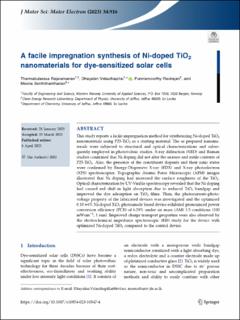| dc.contributor.author | Rajaramanan, Tharmakularasa | |
| dc.contributor.author | Velauthapillai, Dhayalan | |
| dc.contributor.author | Ravirajan, Punniamoorthy | |
| dc.contributor.author | Senthilnanthanan, Meena | |
| dc.date.accessioned | 2023-06-16T13:18:49Z | |
| dc.date.available | 2023-06-16T13:18:49Z | |
| dc.date.created | 2023-05-03T22:00:28Z | |
| dc.date.issued | 2023 | |
| dc.identifier.issn | 0957-4522 | |
| dc.identifier.uri | https://hdl.handle.net/11250/3071837 | |
| dc.description.abstract | This study reports a facile impregnation method for synthesizing Ni-doped TiO2 nanomaterials using P25-TiO2 as a starting material. The as prepared nanomaterials were subjected to structural and optical characterizations and subsequently employed in photovoltaic studies. X-ray diffraction (XRD) and Raman studies confirmed that Ni doping did not alter the anatase and rutile contents of P25-TiO2. Also, the presence of the constituent dopants and their ionic states were confirmed by Energy-Dispersive X-ray (EDX) and X-ray photoelectron (XPS) spectroscopies. Topographic Atomic Force Microscopic (AFM) images illustrated that Ni doping had increased the surface roughness of the TiO2. Optical characterization by UV-Visible spectroscopy revealed that the Ni doping had caused red shift in light absorption due to reduced TiO2 bandgap and improved the dye adsorption on TiO2 films. Then, the photocurrent–photovoltage property of the fabricated devices was investigated and the optimized 0.10 wt% Ni-doped TiO2 photoanode based device exhibited pronounced power conversion efficiency (PCE) of 6.29% under air mass (AM) 1.5 conditions (100 mWcm−2, 1 sun). Improved charge transport properties were also observed by the electrochemical impedance spectroscopic (EIS) study for the device with optimized Ni-doped TiO2 compared to the control device. | en_US |
| dc.language.iso | eng | en_US |
| dc.publisher | Springer | en_US |
| dc.rights | Navngivelse 4.0 Internasjonal | * |
| dc.rights.uri | http://creativecommons.org/licenses/by/4.0/deed.no | * |
| dc.title | A facile impregnation synthesis of Ni-doped TiO2 nanomaterials for dye-sensitized solar cells | en_US |
| dc.type | Peer reviewed | en_US |
| dc.type | Journal article | en_US |
| dc.description.version | publishedVersion | en_US |
| dc.rights.holder | The Author(s) 2023 | en_US |
| dc.source.volume | 34 | en_US |
| dc.source.journal | Journal of materials science. Materials in electronics | en_US |
| dc.source.issue | 10 | en_US |
| dc.identifier.doi | 10.1007/s10854-023-10347-4 | |
| dc.identifier.cristin | 2145276 | |
| dc.relation.project | Direktoratet for internasjonalisering og kvalitetsutvikling i høgare utdanning: NORPART-2016/10237, LKA- 3182/LKA-16/0001 | en_US |
| dc.source.articlenumber | 34 | en_US |
| cristin.ispublished | true | |
| cristin.fulltext | original | |
| cristin.qualitycode | 1 | |

